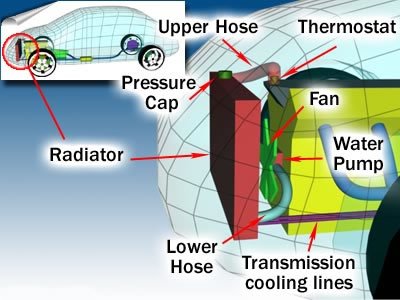Engine Overheating Problems
Gasoline Engines
The first job for the engine cooling system is to keep the engine from overheating. It does this by transferring heat to the air, but the engine cooling system does several other necessary jobs.
The car's engine will run its best at a fairly high temperature. When it is cold, the engine components will wear out faster, and the engine is less efficient and also will emit more pollution. So another necessary job of the engine cooling system is to allow the engine to heat up as quickly as possible, and then to keep the engine at a constant temperature. If the engine overheats then it can cause internal damage to the bearings. Cooling is also needed because high temperatures damage engine materials and lubricants. Internal-combustion engines burn fuel hotter than the melting temperature of engine materials, and hot enough to set fire to lubricants. Engine cooling removes energy fast enough to keep temperatures low so the engine can survive.
Overheating troubleshooting Chart
1) Find the leak in the system and repair the leak. Make sure the water pump belt is on.
- How to find a coolant leak
- How to repair a coolant leak
2) If there is no leak, then look to see if the thermostat is working:
- If one radiator hose is hot and the other cold, then the thermostat is stuck closed
- If both hoses are hot and under pressure, then the thermostat is stuck open.
3) If the thermostat is working correctly and there are no leaks, look to see if the electric cooling fan is operating. If not:
- Diagnose to see if the fan works by applying power to it. Replace if the fan does not come on.
- If it comes on when applying power, check the fuse and relay. Replace as needed.








